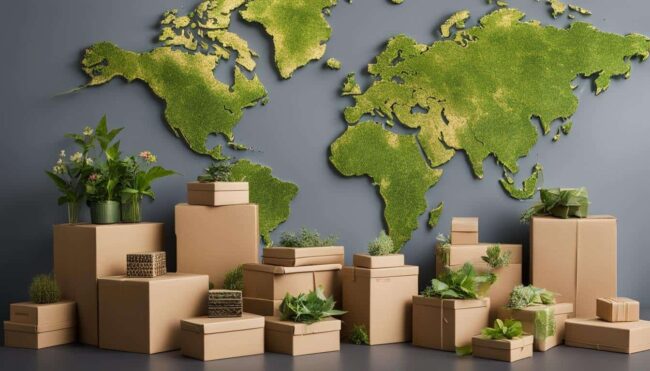In today’s eco-conscious market, businesses are increasingly turning to sustainable packaging solutions. Sustainable packaging minimizes environmental impact by using eco-friendly materials and processes. This shift not only aligns with consumer preferences but also helps companies reduce their carbon footprint and operational costs. In this article, we explore sustainable packaging solutions and how businesses can implement them effectively.

What is Sustainable Packaging?
Sustainable packaging refers to packaging solutions that have a minimal impact on the environment. It involves using materials and processes that reduce waste, conserve resources, and minimize pollution. Sustainable packaging aims to enhance the lifecycle of packaging materials, from production to disposal.
Benefits of Sustainable Packaging
1. Environmental Impact Reduction
Sustainable packaging helps reduce the environmental impact by using materials that are biodegradable, recyclable, or compostable. This reduces waste and prevents pollution from packaging materials ending up in landfills and oceans.
Fact: Switching to sustainable packaging can cut waste by up to 60% compared to conventional packaging.
2. Cost Savings
Although the initial investment in sustainable packaging may be higher, it can lead to long-term cost savings. Reduced waste and improved efficiency in packaging can lower disposal costs and streamline operations.
Pro Tip: Opting for bulk packaging and minimalistic designs can reduce material costs and waste.
3. Enhanced Brand Image
Adopting sustainable packaging enhances a company’s reputation as an environmentally responsible business. Consumers are increasingly making purchasing decisions based on a brand’s environmental practices, leading to increased brand loyalty and market competitiveness.
Insight: Highlighting sustainable packaging efforts in marketing can attract eco-conscious consumers and differentiate your brand.
4. Regulatory Compliance
Many regions have regulations regarding packaging waste and environmental impact. Sustainable packaging helps businesses comply with these regulations, avoiding fines and legal issues.
Fact: Compliance with environmental regulations can prevent costly penalties and improve operational stability.
5. Consumer Demand
Consumers are increasingly demanding sustainable packaging options. Businesses that respond to this demand can improve customer satisfaction and strengthen their market position.
Pro Tip: Offering eco-friendly packaging options can enhance customer loyalty and attract new customers.
Types of Sustainable Packaging Solutions
1. Biodegradable Packaging
Biodegradable packaging breaks down naturally over time, reducing waste and environmental impact. Made from materials like cornstarch or sugarcane, it decomposes more quickly than conventional plastics.
Fact: Biodegradable packaging can decompose in a few months under composting conditions, unlike traditional plastics that can take hundreds of years.
2. Recyclable Packaging
Recyclable packaging is designed to be processed and reused. Materials like glass, paper, and certain plastics can be recycled, reducing the need for new raw materials and minimizing waste.
Insight: Clearly labeling recyclable packaging can improve recycling rates and support waste management efforts.
3. Reusable Packaging
Reusable packaging is designed to be used multiple times before disposal. This includes containers, bottles, and packaging systems that can be refilled or repurposed.
Pro Tip: Encouraging customers to return reusable packaging can further reduce waste and enhance sustainability efforts.
4. Minimalist Packaging
Minimalist packaging uses fewer materials and simpler designs. Reducing excess packaging not only cuts down on waste but also lowers packaging costs.
Fact: Minimalist packaging can reduce material use by up to 50%, leading to significant cost savings and waste reduction.
5. Eco-Friendly Inks and Adhesives
Using eco-friendly inks and adhesives in packaging reduces harmful chemical emissions and environmental impact. These materials are often made from natural or recycled sources.
Insight: Eco-friendly inks and adhesives support overall sustainability and minimize the environmental footprint of packaging.
Implementing Sustainable Packaging Solutions
1. Conduct a Packaging Audit
Start by evaluating your current packaging materials and practices. Identify areas where you can reduce waste, switch to sustainable materials, and improve efficiency.
Fact: A packaging audit helps pinpoint opportunities for improvement and guides the transition to more sustainable options.
2. Choose Sustainable Materials
Select packaging materials that align with sustainability goals, such as biodegradable, recyclable, or reusable options. Consider the entire lifecycle of the packaging to ensure its environmental benefits.
Pro Tip: Partner with suppliers who offer eco-friendly materials and can support your sustainability objectives.
3. Design for Efficiency
Optimize packaging design to reduce material use and improve efficiency. Consider factors like size, weight, and ease of handling to minimize waste and costs.
Insight: Efficient packaging design can enhance logistics and reduce overall environmental impact.
4. Educate and Engage Stakeholders
Educate employees, suppliers, and customers about the benefits of sustainable packaging. Engage stakeholders in sustainability efforts to create a shared commitment to environmental responsibility.
Fact: Stakeholder engagement supports successful implementation and enhances the effectiveness of sustainable packaging initiatives.
5. Monitor and Evaluate
Regularly monitor the performance of sustainable packaging solutions. Evaluate their impact on waste reduction, cost savings, and customer satisfaction to ensure continuous improvement.
Pro Tip: Use metrics and feedback to refine packaging strategies and achieve long-term sustainability goals.
COMMENTS